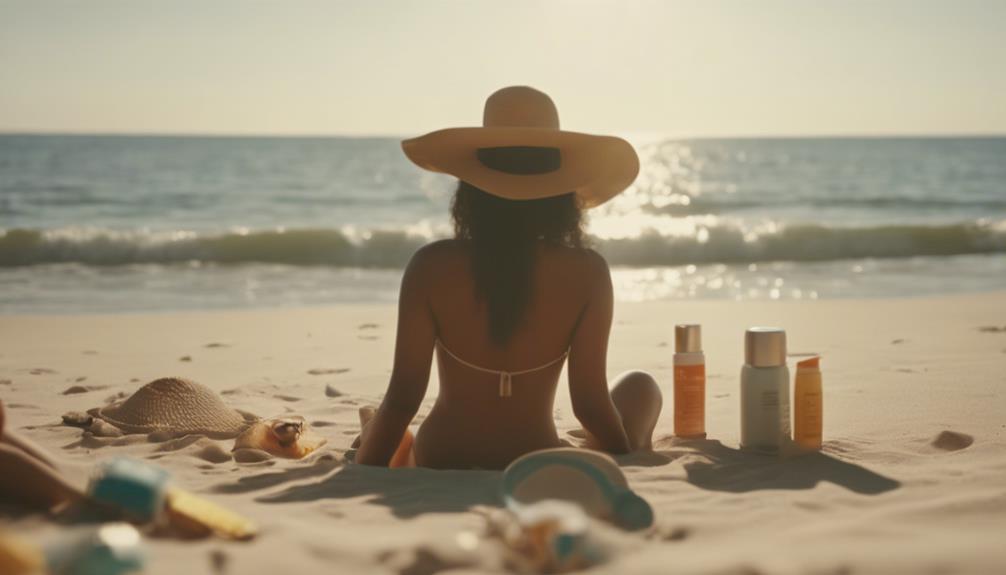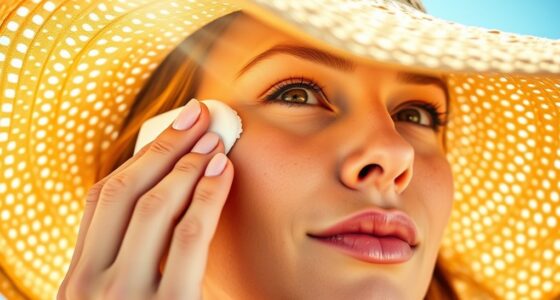To create the best sun protection routine, start by identifying your skin type. If you have oily skin, use a non-comedogenic, oil-free sunscreen. For dry skin, look for moisturizing options with glycerin or hyaluronic acid. Sensitive skin benefits from mineral sunscreens containing zinc oxide or titanium dioxide. Combination skin needs lightweight, hydrating solutions, while mature skin should opt for products with antioxidants. Apply a broad-spectrum sunscreen with at least SPF 30, generously, and reapply every two hours. Don't overlook protective clothing for extra safety. There's much more to explore on how to fine-tune your sun protection!
Key Takeaways
- Identify your skin type (oily, dry, sensitive, combination, or mature) to choose the right sunscreen formulation.
- Use a broad-spectrum sunscreen with at least SPF 30, applying generously 15-30 minutes before sun exposure.
- For sensitive skin, select mineral sunscreens containing zinc oxide or titanium dioxide to minimize irritation.
- Reapply sunscreen every two hours, especially after swimming or sweating, to maintain effective protection.
Understanding Skin Types
To effectively protect your skin from the sun, it's crucial to understand your skin type, as each one has unique characteristics and needs.
First, identify if you have oily skin, which often appears shiny and may lead to acne. You'll want to choose non-comedogenic and oil-free sunscreen formulations to prevent breakouts.
If your skin feels tight or flaky, you likely have dry skin. In this case, opt for moisturizing sunscreens that contain ingredients like glycerin and hyaluronic acid to help hydrate and nourish your skin.
For those with sensitive skin, reactions to products can lead to redness or irritation. Mineral sunscreens are your best bet, as they typically feature soothing ingredients that minimize irritation.
Combination skin presents a unique challenge, displaying both oily and dry areas. You should look for lightweight, hydrating sunscreens that effectively address both concerns without overwhelming your skin.
Choosing the Right Sunscreen

Selecting the right sunscreen is essential for effectively shielding your skin from harmful UV rays while catering to your specific skin type. Always opt for a broad-spectrum formula with at least SPF 30 to block 97% of UVB rays, providing solid protection against sunburn and long-term skin damage.
If you have dry skin, look for moisturizing sunscreens that include ingredients like hyaluronic acid or glycerin. For oily or acne-prone skin, choose oil-free or mattifying formulations to prevent breakouts. Sensitive skin types should consider mineral sunscreens that contain zinc oxide or titanium dioxide, as these are less likely to irritate your skin while forming a gentle barrier against UV rays.
Additionally, tinted sunscreens can offer broad-spectrum protection while helping to even out your skin tone, making them a great multi-functional option. If you're planning outdoor activities, confirm your sunscreen is water-resistant, allowing for longer-lasting protection during sweating or water exposure.
Don't forget to reapply every two hours to maintain ideal protection, keeping your skin safe and healthy under the sun.
Key Ingredients for Protection

Understanding key ingredients in sunscreens can considerably enhance your skin's protection against harmful UV rays. When choosing a sunscreen, look for broad-spectrum formulas that guard against both UVA and UVB rays. These sunscreens are vital for extensive skin protection and minimizing damage.
For sensitive skin, mineral ingredients like zinc oxide and titanium dioxide are effective physical blockers. They reflect UV rays and are less likely to cause irritation.
On the other hand, if you prefer chemical sunscreens, make certain they include avobenzone to shield against UVA rays. Ingredients like octisalate and octocrylene can also enhance the formula's stability.
If you have oily or acne-prone skin, consider sunscreens with niacinamide. This ingredient not only offers sun protection but also helps regulate oil production and reduce discoloration. However, steer clear of sunscreens containing oxybenzone and octinoxate, as they may irritate your skin and raise environmental concerns, especially regarding coral reefs.
Ultimately, selecting the right ingredients is essential for effective SPF protection tailored to your skin type. Prioritize these key components to guarantee your skin remains healthy and safeguarded from the sun.
Application Techniques for Sunscreen

Proper application techniques can greatly enhance the effectiveness of the key ingredients in your sunscreen, ensuring your skin stays protected from harmful UV rays.
To achieve this, you should apply sunscreen generously, using at least 1 ounce (about a shot glass) for full-body coverage and a nickel-sized amount for your face and neck. Choose a broad-spectrum sunscreen with a minimum SPF of 30, as it provides the necessary amount of protection against both UVA and UVB rays.
For ideal absorption, apply sunscreen 15-30 minutes before sun exposure, making sure to cover all exposed areas, including your ears and the back of your neck.
Remember, no sunscreen blocks 100% of UV rays, so it's essential to reapply sunscreen every 2 hours or immediately after swimming, sweating, or towel drying. This helps maintain your skin barrier against the harmful effects of the sun.
If you wear makeup, consider layering your sunscreen underneath and using setting sprays with SPF for additional protection throughout the day.
These techniques will help you achieve healthy skin while enjoying the outdoors.
Special Considerations by Skin Type

When selecting a sunscreen, it's essential to take into account your specific skin type to guarantee ideal protection and care.
If you have sensitive skin, opt for a physical (mineral) sunscreen containing zinc oxide or titanium dioxide. These ingredients provide broad-spectrum protection while minimizing irritation from fragrances and chemicals.
For dry skin, look for moisturizing sunscreens packed with ingredients like glycerin, hyaluronic acid, or ceramides. These formulations will hydrate your skin while offering a sufficient sun protection factor (SPF).
If you have oily or acne-prone skin, choose oil-free, non-comedogenic options that help control oil and reduce breakouts, ideally with added niacinamide.
For combination skin, lightweight lotions that balance hydration and oil control are your best bet.
Finally, if you're dealing with mature skin, prioritize hydrating sunscreens that include antioxidants like vitamin C. These won't only shield your skin from UV damage but also combat signs of aging.
Long-Term Sun Protection Strategies

To maintain healthy skin in the long run, adopt a consistent sun protection routine that incorporates daily use of broad-spectrum SPF 30 or higher. This greatly reduces your risk of skin cancer and premature aging. Remember to reapply sunscreen every two hours, or immediately after swimming or sweating, as UV rays can penetrate through clouds and water.
Additionally, consider integrating protective clothing, wide-brimmed hats, and sunglasses into your sun protection strategy. These items can provide extra shielding against harmful UV rays. When engaging in outdoor activities, choose water-resistant sunscreens specifically designed to withstand perspiration and water exposure.
Regularly assess your skin for changes; if you notice anything unusual, consult a dermatologist for personalized advice on long-term sun protection strategies tailored to your skin type and concerns.
Here's a quick reference table to guide you in your long-term sun protection journey:
| Protection Type | Recommendations | Additional Tips |
|---|---|---|
| Sunscreen | Broad-spectrum, SPF 30 or higher | Reapply every 2 hours |
| Protective Clothing | Wide-brimmed hats, UV-blocking shirts | Choose light colors |
| Consult a Dermatologist | Regular skin checks | Personalized advice |
Frequently Asked Questions
Which Sunscreen Is Best for My Skin Type?
To find the best sunscreen for your skin type, consider your unique needs. If you've dry skin, choose moisturizing options; oily skin benefits from lightweight formulas, while sensitive skin prefers mineral-based products for less irritation.
Which SPF Sunscreen Is Best for All Skin Types?
Choosing the right SPF feels like finding the perfect umbrella in a rainstorm. A broad-spectrum sunscreen with at least SPF 30 works for everyone, shielding your skin from harmful rays while keeping it healthy and radiant.
How to Find the Right Sunscreen Based on Your Skin Type?
To find the right sunscreen, assess your skin type. If you've dry skin, choose moisturizing options. For oily skin, go oil-free. Sensitive skin needs mineral formulas, while combination skin prefers balanced, lightweight lotions.
What Is the Best Skin Protection From Sun?
Imagine your skin as a delicate flower; without sun protection, it wilts under harsh rays. To shield it, use a broad-spectrum SPF 30 sunscreen, reapply every two hours, and wear protective clothing for extra defense.
Can the Sun Protection Routine for Adults be Applied to Kids to Prevent Sunburn?
When it comes to preventing sunburn in kids, the sun protection routine for adults may not be enough. It’s crucial to use specific remedies for kids’ sunburn, such as sunscreen with a high SPF, protective clothing, and seeking shade during peak sun hours. Keep your little ones safe from harmful UV rays.
Conclusion
Incorporating a tailored sun protection routine into your daily life is essential for maintaining healthy skin.
Did you know that nearly 90% of skin aging is caused by sun exposure?
By understanding your skin type and choosing the right sunscreen, you can greatly reduce your risk of damage.
Remember to reapply regularly and use protective clothing when needed.
Prioritizing sun protection now will pay off in the long run, keeping your skin youthful and radiant for years to come.









